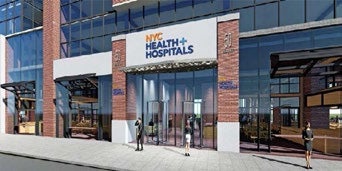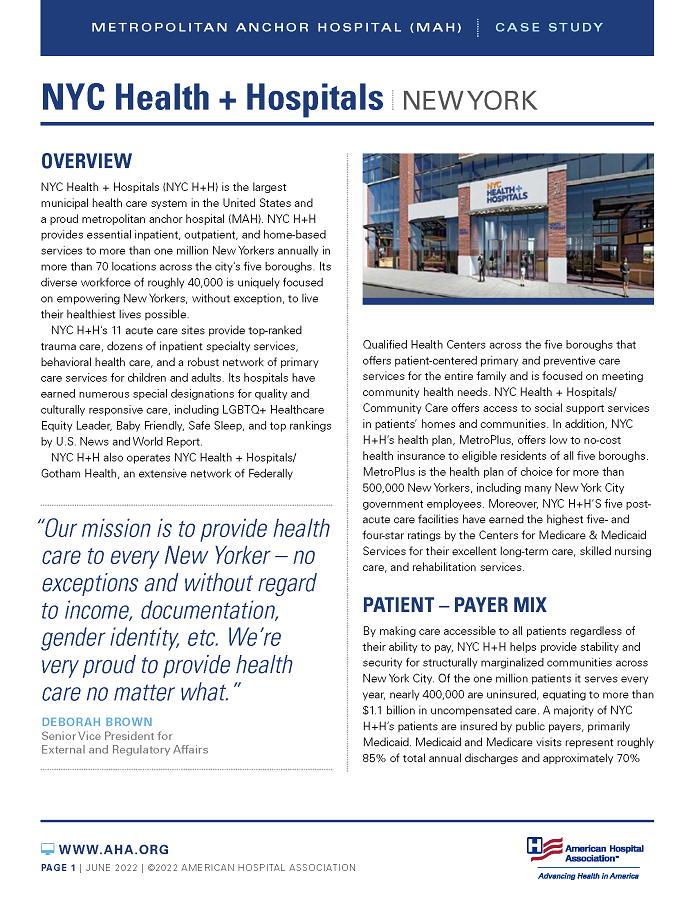

NYC Health + Hospitals | New York
Metropolitan Anchor Hospital (MAH) | Case Study
Overview
 NYC Health + Hospitals (NYC H+H) is the largest municipal health care system in the United States and a proud metropolitan anchor hospital (MAH). NYC H+H provides essential inpatient, outpatient, and home-based services to more than one million New Yorkers annually in more than 70 locations across the city’s five boroughs. Its diverse workforce of roughly 40,000 is uniquely focused on empowering New Yorkers, without exception, to live their healthiest lives possible.
NYC Health + Hospitals (NYC H+H) is the largest municipal health care system in the United States and a proud metropolitan anchor hospital (MAH). NYC H+H provides essential inpatient, outpatient, and home-based services to more than one million New Yorkers annually in more than 70 locations across the city’s five boroughs. Its diverse workforce of roughly 40,000 is uniquely focused on empowering New Yorkers, without exception, to live their healthiest lives possible.
NYC H+H’s 11 acute care sites provide top-ranked trauma care, dozens of inpatient specialty services, behavioral health care, and a robust network of primary care services for children and adults. Its hospitals have earned numerous special designations for quality and culturally responsive care, including LGBTQ+ Healthcare Equity Leader, Baby Friendly, Safe Sleep, and top rankings by U.S. News and World Report.
NYC H+H also operates NYC Health + Hospitals/Gotham Health, an extensive network of Federally Qualified Health Centers across the five boroughs that offers patient-centered primary and preventive care services for the entire family and is focused on meeting community health needs. NYC Health + Hospitals/Community Care offers access to social support services in patients’ homes and communities. In addition, NYC H+H’s health plan, MetroPlus, offers low to no-cost health insurance to eligible residents of all five boroughs. MetroPlus is the health plan of choice for more than 500,000 New Yorkers, including many New York City government employees. Moreover, NYC H+H’S five post-acute care facilities have earned the highest five- and four-star ratings by the Centers for Medicare & Medicaid Services for their excellent long-term care, skilled nursing care, and rehabilitation services.
“Our mission is to provide health care to every New Yorker – no exceptions and without regard to income, documentation, gender identity, etc. We’re very proud to provide health care no matter what.”
Deborah Brown
Senior Vice President for External and Regulatory Affairs
Patient–Payer Mix
By making care accessible to all patients regardless of their ability to pay, NYC H+H helps provide stability and security for structurally marginalized communities across New York City. Of the one million patients it serves every year, nearly 400,000 are uninsured, equating to more than $1.1 billion in uncompensated care. A majority of NYC H+H’s patients are insured by public payers, primarily Medicaid. Medicaid and Medicare visits represent roughly 85% of total annual discharges and approximately 70% of net patient revenue. The relatively small population of commercially insured patients typically visit the system’s trauma center, burn center, snakebite center, and behavioral health programs.
More than 60% of NYC H+H’s patient population identifies as Black, Latino, or Asian Pacific Islander, and 30% of patients are Limited English Proficient (LEP). NYC H+H, like many MAHs across the country, faces significant financial challenges, low margins, and workforce shortages—all of which have been exacerbated by the COVID-19 pandemic.
NYC H+H's Unique Approach to Care
Pioneering Programs to Expand Low-Income New Yorkers’ Access to Care
NYC Care is a health care access program that guarantees low-cost or no-cost services to New Yorkers who do not qualify for or cannot afford health insurance. Through NYC Care, patients receive a unique membership card to access health services through NYC Health + Hospitals, where they can select their own physician and receive affordable prescription medicines. More than 100,000 New Yorkers, 61% of whom live in the hardest-hit COVID-19 areas, now have access to health care through NYC Care.
Commitment to Behavioral Health
NYC H+H provides over 60% of the behavioral health services in New York City. While some systems in the city have closed their behavioral health units due to financial losses, NYC Health + Hospitals doubled down because of its mission to serve everyone. Its public hospitals and neighborhood health centers offer a wide variety of excellent mental health services to foster recovery, help patients rediscover their strengths and abilities, and overcome the stigma of mental illness.
Building the Infrastructure for NYC’s Ongoing Pandemic Response
The initial surge of COVID-19 cases in 2020 was a defining and terrifying moment for New York City. The NYC H+H system was at the “epicenter of the epicenter” of the pandemic’s first wave, treating thousands of patients while simultaneously leading outreach and care for the city. Within a few months of the first positive case in NYC, NYC H+H developed infrastructure and deployed staff to provide COVID-19 testing, contact tracing, isolation services, and later vaccines to all New Yorkers at no cost to them. In addition, NYC Health + Hospitals built three new community-based COVID Centers of Excellence to provide long-term COVID-19 treatment in areas hardest hit by COVID-19 in Brooklyn, Queens, and the Bronx. The pandemic exacerbated existing health inequities and aggravated ongoing health needs, making the work of NYC Health + Hospitals more important than ever.
Metropolitan Anchor Hospitals Need Support
Despite the financial challenges MAHs face, as well as the ongoing COVID-19 pandemic, NYC H+H has accomplished so much for its patients. But in order to be more impactful and adapt to a fast-changing health care landscape, MAHs like NYC Health & Hospitals need help. To empower metropolitan anchor hospitals like NYC H+H to continue serving structurally marginalized communities, Congress must create a federal designation for MAHs and provide adequate, sustained federal support. With such support, NYC H+H could better address its major infrastructure needs, staffing needs (particularly for behavioral health), and programmatic needs including bolstering ongoing support for its LGBTQ+ services, care for those experiencing homelessness, those who are leaving prison and jail and returning to NYC, and, in general, care for uninsured and uninsurable new Yorkers.


